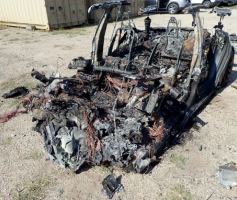— A Tesla crash in Texas in 2021 left first responders believing the 2019 Tesla Model S P100D electric car had no driver when the car crashed and burned, killing both occupants.
The April 2021 Spring, Texas, crash left local authorities baffled because the Tesla driver was found in the back seat while another occupant was found in the front passenger seat.
In a final report from the National Transportation Safety Board, investigators conclude the Model S did have a driver who was drunk when the car crashed and caught fire.
Investigators also concluded Autopilot was not engaged on the Tesla Model S at the time of the Texas crash.
Killed in the Model S crash were Dr. William Varner, the 59-year-old driver of the car, and engineer and passenger Everett Talbot, 69.
Home security camera footage showed both men entering the front driver and passenger seats of the Tesla Model S. The car traveled about 550 feet, exited the road on a left curve, then traveled over a right curb and hit a storm sewer inlet and raised manhole.
The Model S sideswiped one tree and slammed into a second tree. The Tesla caught fire after the crash damaged the front of the high-voltage lithium-ion battery case.
Federal investigators made note of the vacant front driver's seat following the crash, but the NTSB knows the driver's seat was occupied when the crash occurred.
"Although the driver’s seat was found vacant and the driver was found in the left rear seat, the available evidence suggests that the driver was seated in the driver’s seat at the time of the crash and moved into the rear seat postcrash. Specifically, residential security video showed both the driver and passenger getting into the front seats prior to driving away from the residence."— NTSB
The Tesla Model S event data recorder (EDR) data showed accelerator pedal inputs that matched the available evidence and also showed the driver's seat belt was connected when the crash occurred.
Investigators also found a damaged steering wheel, damage that occurred from the impact to the driver's body.
NTSB investigators found the accelerator pedal application was as high as 98.8% and the highest speed in the five seconds leading up to the crash was 67 mph. That was on a road with a 30 mph limit.
According to the NTSB, the probable cause of the 2021 Tesla Texas crash was excessive speed and losing control of the Model S from being drunk. Investigators also determined the alcohol effect was made worse because the driver had taken "two sedating antihistamines."
The driver's blood alcohol level was nearly double the legal limit in Texas.
As part of its final report, the NTSB mentioned the dangers created by electric car battery fires and how those fires can be extremely difficult to extinguish.
The NTSB has recommended standardized emergency response guides to help first responders with vehicles equipped with high-voltage lithium-ion batteries.

